All published articles of this journal are available on ScienceDirect.
Exploring Research Trends in Air-rail Passenger Transport Relationships Through a Content-based Analysis
Abstract
Background:
Air and rail passenger transport was initially considered to be competitive. However, as both modes have been developed, several other forms of relationships have been introduced and become more complicated, leading to the investigation of research trends in the air-rail passenger transport relationship.
Gap:
There are few studies on the relationships between air and rail passenger transport, lacking research synthesis application.
Aims:
This paper classifies and analyzes the relationships between air and rail passenger transport based on research publications between January 2006 and December 2020.
Objectives:
The objective of this study is 1) to investigate the possible forms of relationships the air-rail passenger transport based on existing studies, 2) to reveal research themes and trends, and 3) to propose research potentials in the air-rail passenger transport.
Methods:
The study uses a content-based analysis by deriving research articles from transportation and databases. A total of 472 articles were initially identified and screened. One hundred and forty-five articles were included in the final synthesis.
Results:
Air-rail relationships were categorized as a modal comparison, competition, cooperation, integration and influence. Research has been found to rely heavily on the mixture of modal competition, integration and influence. Furthermore, it has been pointed out that the influence between air and rail passenger transport has a one-way effect; air carriers are affected by the entrance of high-speed trains but not in a reverse direction. China has been an emerging context of this topic over the past five years and is likely to dominate the air-rail research due to its extensive high-speed rail networks and vast developments in large airports.
Conclusion:
In terms of the air-rail infrastructure development, it was suggested that modal cooperation was outdated due to lacking seamless connectivity features. Future research might explore the deficient research disciplines, including transport sustainability, business practices and tourism, as well as the impact of the coronavirus disease pandemic in reshaping the air-rail passenger transport industry.
1. INTRODUCTION
The passenger railway was introduced in the United Kingdom during the industrial revolution, using steam locomotives and operating at a short distance and speed of 50 kilometers per hour (International Union of Railways [1],). Soon after the success of the first public railway, railways networks were developed and extended in many countries in the Americas, Europe, Asia and Oceania. Railroads were used not only for long-distance travel for intercity or across countries and continents but also for public transit in megacities. International and transcontinental railroads peaked and fell during the 19th century, especially when air transport technology advanced faster. After World War II, air transport, introduced in the early 1900s, has dominated international passenger transport until today.
Since speed is one of the major advantages of air transport, railroad innovators have been looking for more promising speed technology for the railroad, and the ‘high-speed train’ concept was introduced during the 1960s. By the 2000s, most countries in Western Europe and Scandinavia commenced high-speed train operations, including AVE in Spain and ICE in Germany, as one of the largest high-speed train networks on the continent. With the increased speed, the high-speed trains in some regions have successfully taken greater market shares when compared with air carriers.
According to one of the earliest air-rail passenger transport studies, Milan [2] compared the quality of the European air and rail passenger networks in the late 1990s, revealing the relationship between both modes of transportation, which was defined as competition. At that time, the network covered major cities of the continent with connectivity to the Russian Federation and East Thrace. The paper indicated a large gap between time-based attributes of the quality of service at both modes. It was also pointed out that the service level of air passenger transport was higher than that of rail. It was concluded that air and rail passenger transport is in a position to compete on the short and medium hauled routes. Givoni [3] further fortified this competitive relationship through his work, indicating the competing distance between air and rail passenger transport to be 600 kilometers in length or a one-hour flight equivalent. Therefore, for the city-pair linked by air carriers’ service and train service, passengers potentially consider high-speed train as a substitute for air travel when the traveling distance does not exceed 600 kilometers.
The other air-rail passenger transport relationships are cooperation and integration, which share similar characteristics. Givoni and Banister [4] discussed the differences between air-rail competition, cooperation, and integration. The most common passenger behaviors incurred in competitive relationships are mode choice and mode substitution decision making. On the contrary, passengers used both modes of transportation in cooperative relationships, one being a complementary service to another. Mostly, train services connected to airports served as feeders, providing passengers the ground transportation to and from airports, while airlines provide passengers inter-city transports that railroad companies do not offer. The integrative relationship has similar infrastructure fundamentals to the cooperative one. However, in this relationship, passengers are offered value-added services that result in a seamless journey and more convenience in modal shift. The value-added services include a single ticket with a check-thru baggage service from the origin (which could be a train station) to the destination (which could also be another train station). The air-rail integration was first discussed in the work of Stubbs and Jegede [5] in 1998, which indicates the situation when the air carriers and the rail operators can collaborate for a seamless modal shift in airports in Britain.
While competing, the effect or influence between air and rail passenger transport may occur, and several researchers have tried to find out the significant result of such effects. Examples of air-rail passenger transport influence include the work of Clewlow et al. [6], who discovered the negative impact of high-speed railways on the domestic air passenger traffic in Europe. In the meantime, the high-speed railways decreased the rail travel time and lowered short-haul air traffic in the study area. Similarly, Dobruszkes et al. [7] evaluated the impact of high-speed railways on the air service level in Europe. It has been found that the travel time of the high-speed railways has a significant impact on the air service level. The work of Wan et al. [8], Chen [9], Zhang et al. [10], Talebian et al. [11], Yang et al. [12], and Zhang et al. [13] also focused on the study related to air-rail passenger transport influence.
With more complex forms of relationships and greater connectivity between air and rail passenger transport, supporting solutions for air and rail intermodality such as park and ride systems and bike sharing were recommended for more efficient and extended urban and intercity transport options, as discussed in Macioszek and Kurek [14] and Macioszek and Kurek [15].
Many studies on air-rail passenger transport included literature reviews focusing on specific issues. Dobruszkes et al. [7] conducted a literature review on the effects of intermodal induced by high-speed railways, including the study’s focus, areas, research methodologies and results. Wan et al. [8] summarized air-rail research with econometric models. Chen [9] focused the literature review on air-rail competition research using quantitative methods. Sun et al. [16] reviewed the research scheme of air transport against high-speed rail under competition and cooperation contexts across selected regions and proposed five research challenges for future research. Zhang et al. [17] conducted an insightful and comprehensive review of the impacts of air-HSR competition on air carriers, airports and regional economies. As the content-based analysis literature review on relationships between air and rail transport has not been complied, this research aims to collect and analyze research articles related to relationships between air and rail passenger transport to point out research themes and trends and to offer research insights into what has been done and what could be done in the future. Air transport in this research includes the study of passenger air carriers (low-cost and full service), airports, and air traffic. Rail transport in this research includes the study of high-speed trains, intercity passenger trains, mass transit trains, and airport rail links.
This study has four sections: introduction, research methodology, results and discussion, and conclusion. The introduction provides a background of this research as well as research aims. The research methodology describes the content-based analysis method, data preparation and data analysis. The third section, results and discussion, show the outcomes of text coding, quantitative outputs, and trend analysis. The last section summarized the research outcomes and limitations and proposed possible adaptions for future studies.
2. RESEARCH METHODOLOGY
A literature review is not only conducted to explore previous studies and identify potential research gaps but also to synthesize research trends when there are sufficient numbers of literature in the study period. One of the synthesis methods that can be applied is content analysis, which, according to Hsieh and Shannon [18], can “subjectively interpret the content of text data through the systematic classification process of coding and identifying themes and patterns.” Content analysis, or a systematic review of literature, has been adapted in many research fields ranging from medical sciences to logistics and transport, as can be observed in the work of Cullinane and Toy [19], Spens and Kovacs [20], Ahi and Searcy [21], Mahpula et al. [22], Moldavska and Welo [23], Hrelja et al. [24], Lagorio and Pinto [25], Karjalainen and Juhola [26], and Aloui et al. [27].
In this study, content-based analysis methodologies include a qualitative analysis – a method used to capture, interpret, and synthesize selected text – and a quantitative analysis, including descriptive statistical outputs. Since this method does not have a standardized quantitative measure to validate the research, it is challenging to prove that the research findings are reliable and trustworthy. The researchers then applied the Preferred Reporting Items for Systematic reviews and Meta-Analyses (PRISMA) checklist and flow diagram published by Moher et al. [28] to verify that the research was properly conducted and met the systematic review’s quality. The procedure of this systematic literature review study can be split into two phases: preparation and analysis.
2.1. Preparation
In this phase, the authors determined the purpose of the study and performed a literature search and screen. As previously discussed in the background section that the focal point of this study is to explore the trend in air and rail passenger transport relationship from existing works, the unit of analysis was covered only with the air-rail passenger transport appeared in the published media.
Moher et al. [28] and Okoli and Schabram [29] laid out literature screening steps that this study follows. Content of screened works as those that appeared in social science journals with subject categories on transportation sciences and focused on only two modes: air and rail transport. This content screening limited journals to those in transportation and social sciences. However, no criteria were applied to authors, research methodology, participants, subjects, intervention, and source of financial support.
The articles were collected from three databases: Scopus, ScienceDirect, and Transport Research International Documentation (TRID). While the first database is one of the largest research databases of peer-reviewed journals in science, technology, and social science, the second and third database contains numerous transportation science publications. Since high-quality journals in transportation science can be founded in all databases, the extracted articles were expected to represent literature in this field. The researchers considered only review and research articles published in peer-review journals. This means monographs, magazines, dissertations, reports, conference proceedings and working papers were excluded. Although some of the literature from those sources is valuable, excluding them from this research could affect the research’s outcomes. However, including only peer-reviewed literature would ensure the quality and homogeneity of the records in this study, as other researchers applied to their works (Gimenez and Tachizawa [30], Netland and Aspelund [31], and Touboulic and Walker [32]).
Therefore, the following criteria were applied in search of articles, including article search words, publication year, language and scope of the study.
Based on the study’s purpose, article search words (including synonyms, abbreviations, and alternative spellings) were identified and grouped as listed in Table 1 below. Keywords in both air passenger and rail passenger transport categories were applied in the search field together by using “AND” to certify that the search results will display relevant articles.
| Air Passenger Transport | Rail Passenger Transport | Integration |
|---|---|---|
| Air | High-speed rail | Air-rail |
| Airlines | High-speed train | |
| Airports | HSR | |
| Aviation | HST | |
| Rail | ||
| Railway stations | ||
| Trains |
According to the earliest publication on the air and rail passenger transport relationship by Givoni [5], the data range was set between January 1997 to December 2020. However, only five articles were discovered and proved for eligibility between 1997 and 2005, and the publication year of those articles is in discontinuous patterns. Therefore, the study period was redesigned between January 2006 and December 2020. As for the language of publication, this study considers only reviews and research articles written in English. Lastly, the study considers only peer-reviewed articles in social sciences under the transportation subject category.
All literature searching and screening steps follow the PRISMA 2009 flow diagram (Moher et al. [28]) as presented in Fig. (1). In the identification stage, 472 records (articles) were identified through database searching without any records identified from other sources. Because the search was performed on three databases, records listed in Microsoft Excel were cross-checked to eliminate duplicated ones. After similar records were removed, 360 records could be advanced to the screening stage. The screening stage was designed to eliminate articles out of a transportation science scope (for example, articles in civil engineering and mechanical engineering) and not the record published in peer-reviewed journals. The researchers reviewed the title and abstract of each article before making the screening decision. There remained 190 records after the screening, and 170 records were removed. In the eligibility stage, the full-text articles were assessed, and 145 articles were selected for further analysis, while 45 were excluded due to lack of air-rail relationship evidence (See Appendix 1 for the full list of records included in the analysis).
According to the PRISMA 27-item checklist (Moher et al. [28]), there are two risks associated with the systematic review: risk of bias in individual studies and risk of bias across studies. The first risk can significantly impact the research outcomes because the bias can incur during manual text coding to identify research themes. Hence, the authors mutually defined each theme’s definitions, individually categorized papers according to themes and reviewed the text coding results to cross-check whether the coding outcomes were consistent or not. This study also encountered the risk of bias across studies because the search limits the scope of literature, type of literature, database of literature, and language of literature. On the contrary, by scoping the records for analysis to only peer-reviewed articles, the conformity and quality of records were assured.
2.2. Analysis
All authors reviewed one hundred and forty-six articles to classify the research themes. Each article's content was extracted to exclude irrelevant texts from the analysis. The authors removed authors’ names and information, footnotes, page header and footer, background, literature review, acknowledgements and references, while study purposes and objectives, main results, discussions and conclusions remained in the text coding. The authors used a systematic literature review software, NVivo12, to perform manual text coding for research themes’ identification and other statistic outcomes such as word frequency summary.
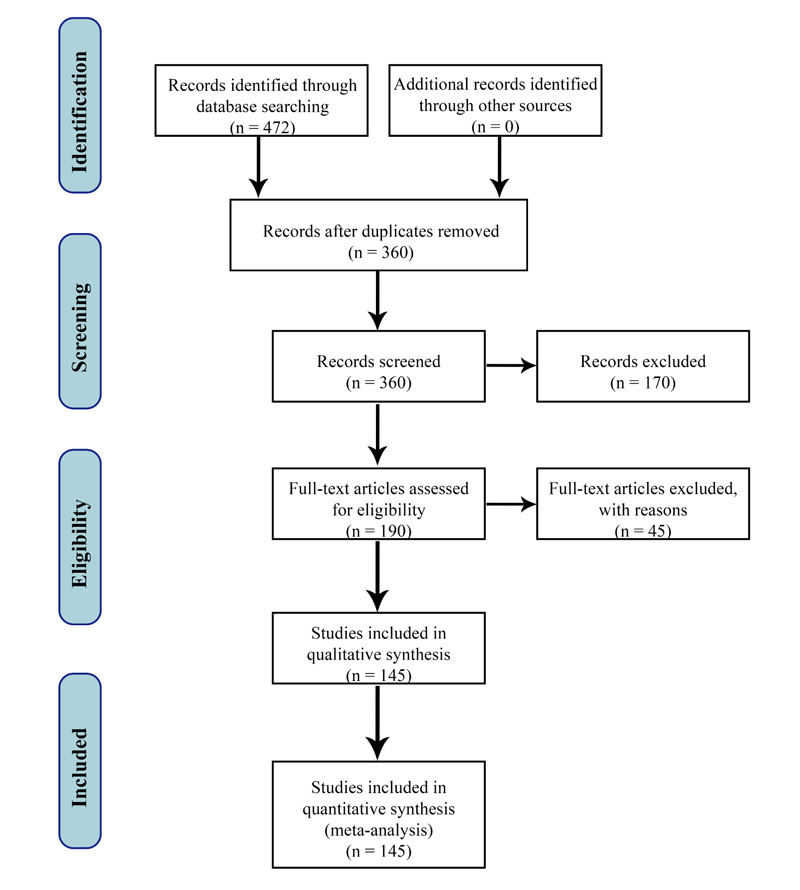
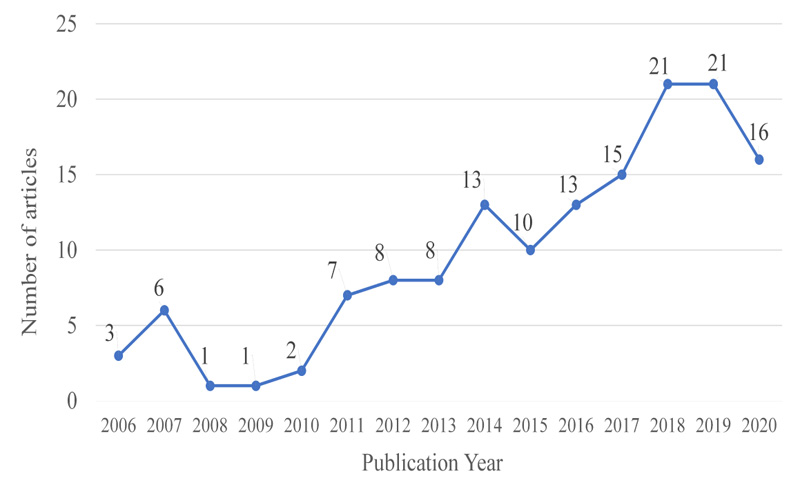
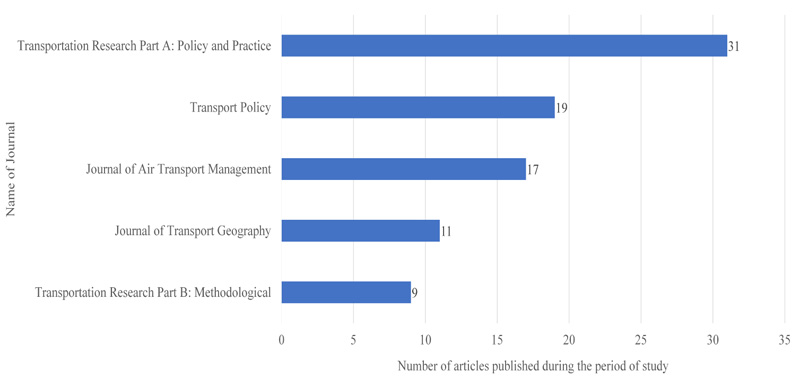
3. RESULTS AND DISCUSSION
3.1. Descriptive Statistics
3.1.1. Publication Year
Approximately 59 percent of the articles in the analysis were published between 2016 and 2020. Fig. (2) depicts the number of articles distribution by year of publication. The study observed an increasing trend in air-rail research, except for the last year of study. The coronavirus disease (COVID-19) outbreak in early 2020 could have been the reason for the lower number of publications of air-rail studies in comparison to the previous years, as IATA [33] and the European Commission [34] have addressed the severity of passenger decline due to a restricted service in both modes, and thus hindered the data collection and data availability for research.
3.1.2. Journal
Articles included in this study were published in 34 different journals. However, the top five journals, which are Transportation Research Part A: Policy and Practice; Transport Policy; Journal of Air Transport Management; Journal of Transport Geography; and Transportation Research Part B: Methodological, contribute 60 percent of articles in this study while the remaining 40 percent of articles were published in the other 29 journals, as can be seen in Fig. (3). (See Appendix 2 for the complete list of journal titles)
3.1.3. Geography
In most articles, geographical research areas were mentioned and considered seriously since the results are likely to vary for different areas. Countries in Europe, if specific ones were mentioned, were considered distinctively. Therefore, Europe has used the case that the research area covers the entire continent. A similar concept applied to Western Europe, East Asia, and Northeast Asia.
For the single country or region group, China is where studies were conducted the most, followed by Spain. Europe is the most mentioned region. Out of 145 articles, 15 did not specify the research's geographical areas. Some of the articles involved multiple geographical areas. An example is the work of Jiang and Li [35], which carried out a macroeconomic comparison between Japan and Western Europe in the cast of low-cost carriers and high-speed rail. The United Kingdom and Europe are the most popular among all country pairs, indicating the significance of travel demands and behaviors between both points.
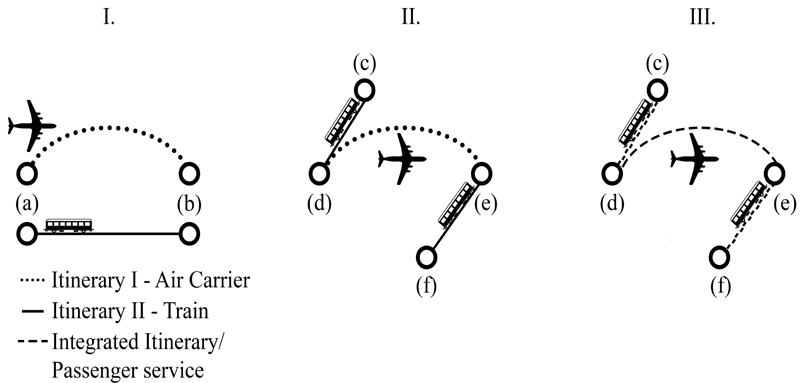
About 51 percent of articles focused on the study between city pairs, city level, regional level, or route-level analysis. Geographic areas were particularly in European, Northeast Asian countries, and China, reflecting the importance of high-speed railway development and air transport toward economic, social, tourism, and urban developments in such areas. Most literature focused on megacities, megaregions, or major corridors such as London-Paris (Givoni [36], Behrens and Pels [37], D’Alfonso et al. [38], Lijesen and Behrens [39]), Madrid – Barcelona (Román et al. [40], Jiménez and Betancor [41], Martín et al. [42]), Beijing-Shanghai (Chen and Lin [43], Ma et al. [44]), Beijing-Guangzhou (Li and Sheng [45]), and Wuhan-Guangzhou (Zhang et al. [46], Zhao et al. [47]) while smaller cities, regions, and less-dense corridors were not considered.
3.2. Word Frequency
A query for word frequency with stem word grouping to group forms of the same lexeme, such as “airline” and “airlines, ” was carried out with NVivo 12. A synonym function was omitted. The minimum word length was set to 3 letters to include the word “hsr” (abbreviation of high-speed rail) and “air” in the analysis. It was discovered that “hsr” was the word with the highest frequency (13,981 counts), followed by “air” (11,684 counts), “transport” (10,563 counts), “airline” (9,133 counts), “rail” (8,014 counts) and “airport” (7,500 counts). “Competition” was the only research theme that hit high-frequency ranking (4,754 counts) (See Appendix 3 for the list of top 20 words frequency).
3.3. Research Theme
As discussed in the introduction section, various forms of air and rail passenger transport relationships exist. The articles were classified under five research themes: modal comparison, competition, cooperation, integration, and influence, using the text coding function in NVivo12 software. Each research theme can be described as follows.
The modal comparison includes the articles focusing on air and rail passenger transport’s comparison in a certain dimension, as in the work of Milan [4], that compared the network quality and Chiara et al. [48], that analyzed and compared energy consumption between both modes.
The modal competition, modal cooperation and modal integration followed the concept described by Givoni and Banister [7]. Fig. (4) illustrates the differences between these three themes. In the modal competition, airline and train companies are direct rivals, providing service on the same route: the travel from origin or city (a) to destination or city (b). Since the relationships between air and rail passenger transport are described as opposition, articles in this research theme generally addressed one of the following issues. First is the mode choice decision in which passengers must choose either air travel or train service under the condition that services of both modes are offered, as in the work of Martín et al. [42], Chen [49], and Jiang and Ren [50]. Second, mode substitution, or the situation where one mode of transportation can be used when another mode is unavailable or out of service, as in the study of Castillo-Manzano et al. [51] and Chen et al. [52].
As for the modal cooperation, air and rail passenger transport infrastructure are linked and do not compete directly. The train service served airlines as a feeder, providing city (or in some cases, intercity) rail links to major airports. Therefore, in this relationship, passengers can travel to the departing airport (d) using a train service from their origin (c). They can also use another train service at the arriving airport (e) to connect to their actual destination (f). Train stations can be situated in the airport or close by. However, a passenger using an air-rail link in modal cooperation must purchase air and train tickets separately and handle their baggage during transit. The evaluation of direct rail service as the new land access mode choice to a low-cost airport by Birolini et al. [53] is considered modal cooperation because the proposed rail systems only act as a feeder to the airport without any partnership feature.
In modal integration, air and rail passenger transport infrastructures are similar to modal cooperation. However, passengers can travel seamlessly in this relationship using a single booking or integrated itinerary for all transportation services. Hence, they can use train service from a city station (c) (some with check-in counter and baggage handling service option), transfer to an air carrier at the departing airport (d), and use another train service from the arriving airport (e) to their actual destination (f) while baggage is also delivered to the designated train station. Partnership features must appear in this relationship, as Li et al. [54] have analyzed the air-rail collaboration cases that include multi-level attributes for partnership, including integrated ticketing, online reservation, assistance for train/flight delay or cancellation, a loyalty program for frequent flyers, code-sharing, schedule coordination and other end-to-end services. It was also pointed out that the success of the air-rail partnership is the co-location of air and rail passenger service, and proximity may not be enough. A study by Chen and Lin [43] supported this concept and concluded that the air and rail integration in Shanghai Hongqiao international airport and Shanghai Hongqiao railway station is restricted because the airport and railway station do not situate in the same facility, resulting in inconvenient transfer between air and train service.
Because the modal cooperation and the modal integration are relatively close, the text coding for modal integration was based on activities incurred from seamless journeys between air and rail transport, while for modal cooperation, text coding was based on air-rail connectivity without air-rail partnership features. The research on air-rail revenue sharing (Xia et al. [55],) indicated the middle ground between modal cooperation and modal integration through the revenue sharing scenarios. It can be concluded that the air-rail revenue-sharing agreement will be more likely to reach when the HSR operator is social welfare-oriented (in other words, the HSR fares are more achievable for passengers). This suggested that air-rail relationships leading to win-win scenarios do not always have to be the integration relationship. However, a high level of cooperation between both modes is mandatory.
In this study, the modal influence refers to a situation when one mode of transportation, such as high-speed rail, impacts or affects another mode, which is air transport. The impact may lead to air-rail competition, cooperation, integration, or strategy adoption. Therefore, the work of Chiambaretto and Fernandez [56] was viewed as a modal influence since the paper investigated low-cost marketing practices used by the air carriers that the rail operator can adopt in France by using interviews and secondary data analysis. Key success factors and directions for a low-cost rail business model were suggested.
Articles eligible for quantitative and qualitative analysis were coded in the systematic literature review software. Research themes were created as nodes in the software. One hundred and ninety sources were coded with 381 references. These figures indicated that some articles were coded under more than one node, which is explainable because modal influence could induce other modal relationships. Fig. (5) depicts an air-rail research themes cluster analysis based on text similarity in the form of a dendrogram, which grouped similar and dissimilar themes further apart. It can be observed that the modal influence and competition were grouped in the right-most branch, meaning these two research themes have the closest relativity or tend to appear rather than other themes.
Relativity between research themes can also be quantitatively described using the Pearson correlation coefficient, as shown in Table 2. This coefficient measures a linear correlation between research themes. It can be seen that modal competition, modal integration and modal influence form strong positive correlations, with the modal influence – competition yielding the strongest positive correlations with a coefficient of 0.826483, followed by modal integration – competition and integration – influence, respectively. Conversely, the modal competition – cooperation, influence – cooperation, and cooperation – comparison show weak positive correlations. Apparently, the air-rail competition and influence are more likely to be an inseparable relationship in the fully integrated air-rail infrastructure systems while the air-rail cooperation seems to diminish.
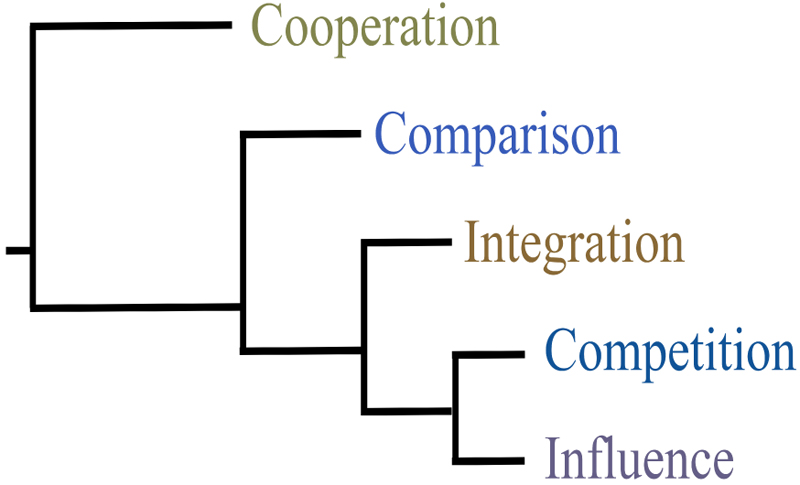
| - | Competition | Integration | Influence | Comparison | Cooperation |
|---|---|---|---|---|---|
| Competition | 0.000000 | - | - | - | - |
| Integration | 0.727248 | 0.000000 | - | - | - |
| Influence | 0.826483 | 0.747948 | 0.000000 | - | - |
| Comparison | 0.670913 | 0.559359 | 0.567216 | 0.000000 | - |
| Cooperation | 0.287493 | 0.376594 | 0.242026 | 0.241945 | 0.000000 |
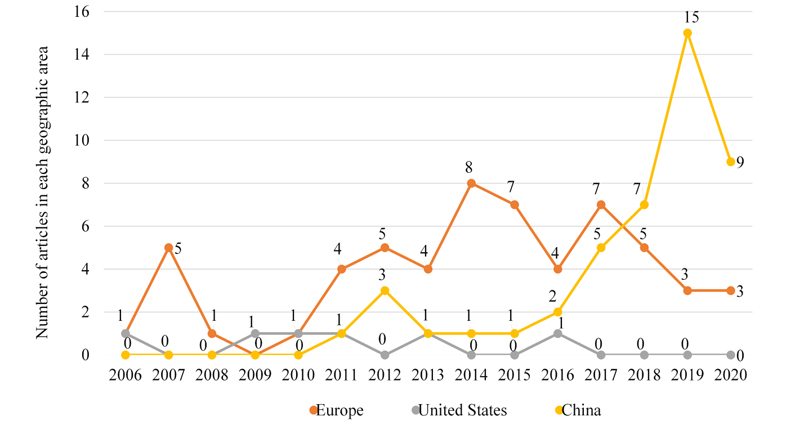
By considering each research theme individually, modal competition (or the competition node in the software) is the dominating research theme, with text coding from 94 sources out of 185 references. In contrast, modal cooperation seems to appear in a few works of literature, such as the study by Mathur and Srinivasan [57]. To successfully initiate a high-speed railways project in the United States, “synergistic relationships” or partnerships between air and rail infrastructure are mandatory.
All articles coded in modal influence theme show a congruence outcome: air transport is impacted by the high-speed trains’ operations but not vice versa, which means the influence is one-way. However, some high-speed train operators applied low-cost strategies initiated by air carriers. This one-way influence was also discussed by Takebayashi [58] that air-rail collaboration improved the welfare of international passengers if good connectivity existed. However, only the airlines would be motivated to collaborate, but there was no beneficial incentive for the high-speed rail.
3.4. Trend Analysis
As discussed in section 3.1, the number of publications has risen continuously since 2011 and approximately fifty-nine percent of articles were published from 2016 – 2020. The geographical areas of research are mainly China and Europe. Both areas have one characteristic in common: the mature air and rail transport industry that can accommodate data collection and analysis. Fig. (6) presents the number of articles focusing on three geographic areas (Europe, United States, and China) distributed by the year of publication.
Europe has dominated the air-rail relationship research for most periods, while research in air and rail transport focusing on China appeared after 2010. Although Europe remained the dominant geographical research area during the 2010s, China has recently become the emerging research trend in air-rail linkage, with the number of publications involving Chinese air-rail transport exceeding European air-rail transport in 2018. The United States, on the contrary, has the greatest number of airports in the world (CIA [59]) and has one of the best air infrastructures; it is still lacking a high-speed rail system due to the high popularity of air transport. As a result, rail transport for intercity passengers is uncompetitive (William et al. [60]). The country has been planning on a high-speed rail system for decades, but infrastructure development has not been realistic. Literature concerning the air-rail relationship in the United States discussed mainly the proposition of airport rail links, intercity passenger rail and high-speed rail system (Rhoades et al. [61], Mathur and Srinivasan [57], Chen [49], Chen [62], and Talebian and Zou [63])
Fig. (7) visualizes the trend of the research theme from 2006 to 2020. In the early years, research involving modal influence and modal comparison was quite rare, while modal competition appeared to be the theme of interest from the beginning period of study. It can also be spotted that modal cooperation was no longer the research interest after 2009. From 2011 to 2020, research in the modal competition was still prevalent while modal integration and modal influence gradually gained attention due to more active air-rail collaborations, business development, and engineering and technology advancement, leading to better integration between both modes. This coincides with the theme analysis in Section 3.3 that research on air-rail competition has been recently carried out together with modal integration and modal influence. In addition, this result is supported by a comprehensive review and analysis of Zhang et al. [17] on how high-speed rail and air transport can compete, integrate, and affect each other as substitution and complementary modes of transport.
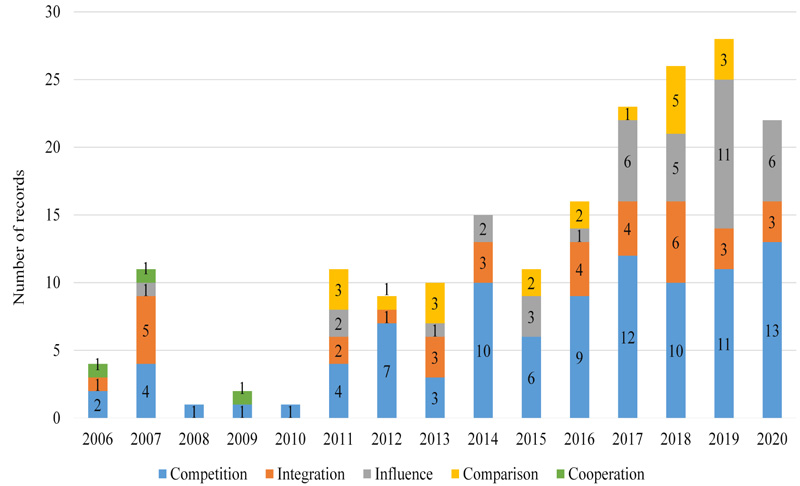
4. RESEARCH THEME
This study has addressed research development in the relationship between air and rail transport. It is undeniable that modal competition has been the most prevalent research theme for the entire study period. Second, the modal influence, competition, and integration form strong relativity, which can be concluded that the air-rail relationships are not directly competitive. Air carriers and train operators are now competing, influencing and complementing each other, depending on the network and level of collaboration. Clearly, modal cooperation is not a solution for air-rail connectivity. Modern airports are connected to a rail link to the city, providing a seamless journey with associated partnership features. Nonetheless, air-rail integration projects can be unsuccessful. In Bangkok, Thailand, the airport rail link connecting Suvarnabhumi International Airport and Bangkok city center was initially designed for air-rail integration activities. There were check-in counters for airlines, baggage handling service, and flight schedule monitors at Makkasan City Air Terminal. Passengers can also transfer to the conventional rail system operated by the State Railways of Thailand and the mass rapid transit system (Bangkok subway) at this terminal. However, those services were terminated not long after the airport rail link started its operations, relegating the integration relationship to air-rail cooperation and leaving the established infrastructures unused. Although Weerawat et al. [64] proposed the operational challenges of Bangkok Airport Rail Link with the new extended service linking between three major airports in Bangkok and Chonburi by using rail simulation, the air-rail integration scheme has not been addressed. Hence, the investigation on how air-rail integration ended up ineffective and studies on how to promote the relationship from modal cooperation to a successful model integration can also be carried out.
It can also be noted from the analysis that airlines and airports were affected by high-speed trains, which stimulates incentive for airlines to collaborate with high-speed train operators, while the study on how high-speed trains could be affected by air transport is still limited. Furthermore, from the analysis of geographical areas of research, it can be observed that most literature focuses on megacities, megaregions, and major air-rail corridors. The research gap here is the coverage of smaller cities, regions, and less-dense corridors in the air-rail relationship investigation. Beyond that, works on air-rail influence were conducted based on the active operations of rail and air transport. However, very few studies have discussed this relationship at the planning and preparation stage of new rail infrastructure development, which could have impacted the sustainability of the air-rail connectivity. The United States seemed to be the only exception in this case. Hence, it is recommended that there should be an evaluation and assessment of high-speed rail’s influence on air transport in the countries where high-speed rails are soon to be introduced to plan for sustainable air-rail transportation systems as well as to propose mitigation and integration strategies for air carriers, airports, and air traffic.
4.1. Challenges, Concerns, Prospects of Air and Rail Transport
One of the biggest challenges in air transportation would be the direct and intense competition from the high-speed train. With the pressure on airfares and decreasing air travel demand, the airlines were forced to either cut seat capacity, withdraw from the market, or continue to battle the price war while retaining their service level. Air-rail integration seemed to be favorable for both modes. However, certain research indicated the motivation was generally from the airlines’ side, as discussed in Section 3.2. Furthermore, severe weather has been the major restriction for air transport, resulting in airlines’ compensation program expenses. Interestingly, Zhou and Chen [65] revealed that airport resilience could accommodate delays caused by poor weather conditions prohibiting aviation operations through modal substitution. With the existence of high-speed train service, air service recovery was faster than the airport without a high-speed train system as an alternative mode.
While airlines face threats from the entrance and existence of high-speed trains, on the other hand, the high-speed train has its challenges from the nature of the infrastructure’s high investment. Long-term infrastructure development requires extensive planning for transit-oriented development. Investment burdens in many countries slowed down the developing project or resulted in underperforming outcomes. Sresakoolchai and Kaewunruen [66] discussed both benefits and risks of adopting a public-private partnership (PPP) in the high-speed train project linking three airports in Thailand, pointing out not only investment and interest burdens but possible constraints on the project development. Peetawan and Suthiwartnarueput [67] also pointed out success factors for rail infrastructure development projects in Thailand, with rail development master plan, transit-oriented development, and PPP opportunities as one of the most successful factors. Seemingly, well planning for rail infrastructure development with clear and strong government policy and direction, coordinated risk mitigation and management among stakeholders are required for the project's success. This prospect aligned with recommendations made in section 4.1.
4.2. Research Discipline
Although research discipline was not quantitatively analyzed, the authors noticed that the literature included in this study focused largely on economics (passengers’ demand, supply, cost, fare, profit, market share, market structure, market response, willingness to pay, consumer surplus, value of time and welfare) and operations (airport classification, airport capacity, airport and air traffic, route and network management, and service quality), while few works discussing the air-rail relationship in the context of the environment, tourism, social impact, urban planning, transport sustainability, and business strategies and practices.
As part of the results of solid studies in air-rail competition, ticket pricing was largely discussed, especially on the price war between both modes, which could have been linked to research schemes on developing and adopting business strategies and practices for airlines to survive the tough competition with rail operators.
Time is also one of the key decisions for selecting a mode of transport, especially in city pairs where the competitions between both modes are intense. Evidently, Wang et al. [68] addressed that travel scheduling played a major role in the air-rail competition. Different modes schedule high-frequency departures at different times to avoid clashes in flight and train timetables and thus allow both parties to cover travel demand within a day.
4.3. Other Possible Trends
The COVID-19 pandemic in early 2020 has a critical impact on the global aviation and high-speed rail industries, resulting in shrunken demand for air and rail passenger transport. Passenger behaviors and mode choices are also affected because of country lockdown, public transport trip restrictions and health and sanitization protocols. Zhang et al. [69] have addressed the roles of public transport, including the high-speed train and air carriers, in the COVID-19 pandemic in China, with a particular focus on distance from Wuhan, the origin of the outbreak. Several investigations on the consequences of the pandemic on the transport sector have been carried out, including Sun et al. [70], Rothengatter et al. [71] and Wang et al. [72]’s review on the impact of the outbreak. Zhang et al. [73] and Harrington and Hadjiconstantinou [74] are on a shift in traveling behaviors, and Xin et al. [75] and Osorio et al. [76] are on urban transit ridership. Therefore, it would be interesting to study how COVID-19 has reshaped the aviation and rail transport industry and the air-rail relationships in the post-pandemic period.
This research has not only the trustworthiness and reliability of content analysis issues but also other limitations. First, the study emphasized only air and rail passenger transport relationships and did not address in-depth analysis on other aspects such as methodology. Second, the scope of the research includes only English articles published in peer-review journals from three databases (Scopus, ScienceDirect and TRID). Furthermore, the number of analyzed articles was clustered in recent years. About two-thirds of articles were published in 2015 – 2020, which could also affect the research trends.
LIST OF ABBREVIATION
| TRID | = Transport Research International Documentation |
CONSENT FOR PUBLICATION
Not applicable.
STANDARDS OF REPORTING
PRISMA guidelines were followed.
AVAILABILITY OF DATA AND MATERIALS
The data supporting the findings of the article is available in the Zenodo Repository at https://zenodo.org/record /7063636/ reference number 7063636.
FUNDING
This research was funded by the International Academy of Aviation Industry, King Mongkut’s Institute of Technology Ladkrabang.
CONFLICT OF INTEREST
The authors declare no conflicts of interest, financial or otherwise.
ACKNOWLEDGEMENTS
Declared none.
SUPPLEMENTARY MATERIAL
PRISMA checklist is available as supplementary material on the publisher’s website along with the published article


